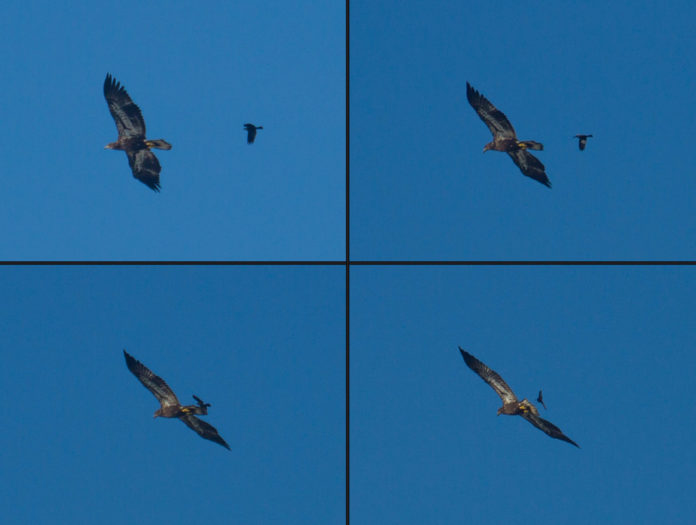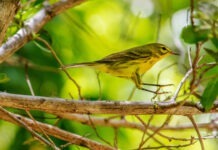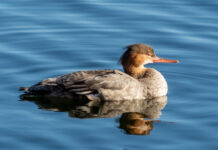I was up at Hugh’s View a few weeks ago, on the roof of The Studios of Key West, making small talk about art and stuff, when a broad-winged hawk flew over. It glided slowly on a long, flat flight path, maybe 30 feet above the treetops. It looked a little haggard, largely because it was molting and had lost some primary feathers — the avian equivalent of someone who’s missing a few teeth.
Somewhere between the federal courthouse and the Methodist church, a pair of northern mockingbirds rose up like F-18s intercepting an enemy bomber. They came up behind him and started screaming in their ratchety manner, diving at him, snapping their bills at his feathers, doing everything they could to harass him, sometimes taking turns, sometimes going at it together.
If there were subtitles to this skirmish, they would have read like: “Hyah!” and “Nothing to see here!” and “Move along, you Sterno bum!”
I imagine there would have also been more than a dram of profanity.
It seemed a brave move – two songbirds picking a fight with an alpha predator, a bird-eating bird that sometimes consumes mockingbirds for actual lunch. It was your basic David vs. Goliath scenario, but with the pair of Davids acting like punks, and with a good chance that things would not turn out as they do in the biblical parable. The hawk, though, did not fight back. It flapped a couple of times to speed up, but held its line.
Somewhere near the square tower of Key West Theater the mockingbirds broke off their assault. One of them dropped from view. The other circled back and landed on a railing, eyeing the small group of people with cocktails in their hands. Was it catching its breath? Showing off? Debating whether to attack us next?
Hard to say. All were possibilities, but birds can be inscrutable. After a few seconds the mocker leaped off the railing without ceremony and dropped from view.
Over near Duval Street a gray kingbird came up and took over where the mockingbirds left off, harassing the broad-wing until it disappeared behind the La Concha.
Mobbing is one of the ancient fighting tactics. Older than stabbing people with swords, or even with sharpened stones. Older, probably, than punching people in the face.
Mobbing is basically when a smaller bird, or often a bunch of smaller birds, gangs up on a larger predator. The intent typically is to kick them out of their turf. It usually happens during nesting season, when vulnerable eggs and chicks need protection and everybody’s hormones are ramped up.
It’s one of those many behaviors – both avian and human – that shouldn’t work, but does. What, exactly, can a 1.7-ounce bird do to a creature with 10 times its body mass, not to mention a pair of skin-piercing talons and a flesh-tearing bill?
For all the Sturm und Drang that comes with mobbing, the understanding of its root causes and intentions are mostly speculative.
It may be to annoy a predator into leaving an area. It may be to distract them from noticing the defenseless chicks and eggs. It may be to teach other, younger birds what a predator is and how they are not to be tolerated. It may be a way to alert other birds that something dangerous is coming their way. And it may be a combination of some or all of those things.
How does one even study such fleeting and unpredictable behavior?
There is also some debate as to whether this counts as altruistic behavior, i.e. a bird risking its own safety to help others, or selfish behavior, i.e. a bird really just trying to make sure its DNA gets passed along to future generations. But honestly, that sounds more like a philosophical debate than a scientific one.
In these parts, the predators you see getting mobbed are mostly hawks and the occasional eagle. The mobbers tend to be northern mockingbirds, red-winged blackbirds, gray kingbirds and common grackles.
In the summer, it’s pretty common to see an osprey getting mobbed, which I always find a little sad. Ospreys only eat fish. They’re no threat to songbirds. You’d think after a few millennia they could all work out a truce.
And while mobbing is a risky behavior, it may not be as dangerous as it seems. Most predators rely on a combination of stealth, surprise and speed to capture their prey. That advantage is greatly diminished when a bird is close behind you, and acting all spastic and aggressive.
Mobbing does not just happen to birds. I received a message through Florida Keys Audubon Society’s website (keysaudubon.org) a few weeks ago from a woman in Marathon. She said every time she left the house with her dog, some bird kept attacking them and she wanted to know what gives.
The short version? Whatever bird it was – most likely a northern mockingbird or gray kingbird – probably considered them predators. They were getting mobbed.
Birds have mobbed my German short-haired pointer more than once. For a long time she flatly refused to walk down certain blocks of Duval Street because mockingbirds had mobbed her.
Despite my best efforts to calmly explain that there was nothing they could really do to her, she yanked on her leash to turn the corner.
It didn’t help my case when, one night a couple of summers ago, I had her trotting next to my bike as I rode through Bayview Park.
A gray kingbird came out of nowhere and nipped her in the butt. She bolted. Unfortunately I had the leash wrapped around the hand on the side with the good brake and we were heading for an intersection. I had to drag a foot the length of a tennis court to stop us.
We both stood there for a minute, breathing heavily, waiting for something to come at us fast and unseen in the dark.


























